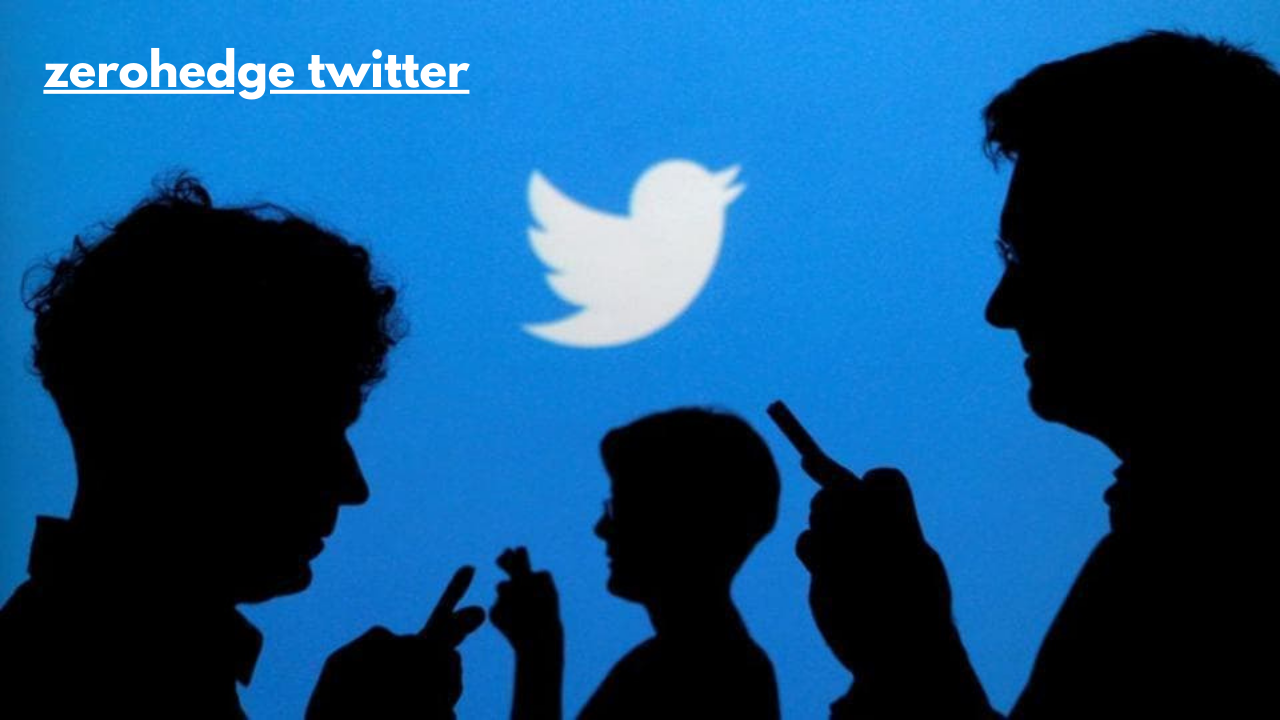Inside the World of ZeroHedge Twitter: Influence, Controversies, and Market Impact
In the digital age, financial information moves at lightning speed, and platforms like Twitter have become crucial for shaping investor sentiment and public opinion. Among the voices dominating the finance corner of Twitter is ZeroHedge, an account that has gained a reputation for its provocative takes, rapid news sharing, and unapologetically contrarian stance. With over a million followers and a fiercely loyal audience, ZeroHedge has transformed from an obscure finance blog into a powerful force on social media.
Twitter, with its real-time nature and viral potential, serves as the perfect stage for ZeroHedge to broadcast its views. The account doesn’t just report news—it curates and comments on it with an edge that appeals to those skeptical of mainstream narratives. Whether it’s breaking news about Wall Street, commentary on central banks, or geopolitical shocks, ZeroHedge’s Twitter presence is relentless and highly engaging.
This article delves deep into the phenomenon that is ZeroHedge Twitter—exploring its origins, strategies, influence, and the controversies it stirs. From influencing market behavior to being banned and reinstated, ZeroHedge’s journey on Twitter reflects the complex relationship between freedom of expression and the power of digital media in the financial world. Let’s unpack the full story.
The Rise of ZeroHedge: A Brief Background
ZeroHedge was launched in 2009 during the aftermath of the global financial crisis. Its founders—initially anonymous—crafted a platform that would challenge the status quo of financial media. Using the pseudonym “Tyler Durden,” a nod to the rebellious character from Fight Club, the site quickly drew attention for its alarmist headlines, deep dives into economic policy, and criticism of central banks and government bailouts. Its anonymity added intrigue, giving it a rogue journalist feel that resonated with disillusioned investors and alternative thinkers.
The site thrived by offering a mix of financial analysis, market commentary, and occasionally sensationalist headlines that others hesitated to publish. Readers seeking unfiltered takes on global finance flocked to ZeroHedge, especially during times of market volatility. Unlike traditional outlets, it had no qualms about highlighting conspiracy theories, alternative data interpretations, or bleak economic outlooks. This radical editorial approach helped the site build a niche but fervent following.
Over time, ZeroHedge evolved from a fringe blog into a recognizable brand in the financial media ecosystem. Despite criticism from mainstream analysts, its reach expanded beyond finance enthusiasts to broader political and economic spheres. The platform’s tone remained anti-establishment, positioning itself as a watchdog on Wall Street and Washington. With this foundation, ZeroHedge transitioned seamlessly into Twitter—an environment ripe for real-time opinion and high-volume engagement.
ZeroHedge on Twitter: Strategy, Reach, and Engagement
ZeroHedge’s Twitter handle, @zerohedge, is one of the most active and followed finance accounts on the platform. Its strategy hinges on speed, volume, and tone. Tweets are often rapid-fire, sometimes dozens in a single day, covering everything from stock market movements and economic indicators to political turmoil and banking crises. The content is usually short, punchy, and laced with sarcasm or skepticism—a perfect match for Twitter’s format and culture.
The account has amassed over a million followers, including retail investors, hedge fund managers, crypto enthusiasts, and even journalists. One of the key factors behind this reach is its immediacy—ZeroHedge often tweets breaking news before major outlets catch on. Whether it’s a sudden drop in oil prices or a surprise interest rate decision, ZeroHedge is typically among the first to post, adding its signature cynical twist. This speed positions it as a real-time resource, not just commentary.
Engagement levels are high. ZeroHedge frequently garners thousands of likes, retweets, and replies per post. The account uses click-driven headlines, sensational phrasing, and sometimes controversial takes to fuel interaction. This strategy, while effective for reach, also leads to criticism for prioritizing virality over accuracy. Yet, the formula works. Followers appreciate the candor, even if they don’t always agree with the message. The Twitter feed reads like a nonstop stream of global disruption—perfect for those who distrust polished narratives and crave alternative perspectives.
Influence on Financial Markets and Public Discourse

ZeroHedge’s Twitter presence doesn’t just entertain—it influences. Many traders, analysts, and financial journalists monitor the feed for early warnings, insider rumors, and alternate interpretations of economic data. A well-timed tweet from ZeroHedge can stir conversations across trading floors or cause a flurry of Google searches as people try to verify the information. In an era where markets are increasingly driven by headlines, the power of such a Twitter account cannot be underestimated.
Take, for instance, the early days of the COVID-19 pandemic. ZeroHedge was among the first to speculate on the virus’s potential global impact, long before major outlets gave it significant coverage. Though the posts were sometimes accused of fear-mongering, they alerted many to the seriousness of the situation. Similarly, in crypto markets, ZeroHedge’s coverage of Bitcoin volatility or regulatory developments can drive temporary shifts in sentiment among retail investors.
Beyond markets, the account shapes broader public discourse around monetary policy, fiscal decisions, and global conflicts. It often challenges official statements, suggesting alternative motives or highlighting contradictions. While some of this commentary verges on conspiracy, it appeals to readers wary of corporate media. As a result, ZeroHedge plays a role in shaping the collective narrative, especially within libertarian, conservative, or alternative economic circles.
Controversies and Criticisms Surrounding ZeroHedge Twitter
ZeroHedge has never been far from controversy, especially on Twitter. The account was temporarily suspended in early 2020 for allegedly spreading misinformation about COVID-19, specifically linking the virus to a Chinese scientist without concrete evidence. The incident sparked debates about censorship, with some accusing Twitter of silencing dissenting voices, while others applauded the move to curb potentially harmful content.
Accusations of fear-mongering and conspiracy theories are frequent. Critics argue that ZeroHedge amplifies fringe views and uses sensationalism to drive traffic. Claims that the account promotes a pro-Russian or anti-Western bias have also surfaced, especially in its coverage of NATO, Ukraine, and U.S. foreign policy. While the site denies any political alignment, the tone and content often skew toward challenging Western institutions and promoting alternative global powers.
Fact-checkers and economists often push back against ZeroHedge’s narratives, pointing to inaccuracies or lack of credible sourcing. Yet, because the account operates anonymously and independently, there’s little accountability or editorial oversight. The result is a polarizing presence—some see it as a necessary counterweight to mainstream media, while others view it as a source of disinformation.
Despite these controversies, the account remains active and influential. Twitter reinstated it after the 2020 ban, and its following has only grown since. The balance between free speech and responsible publishing remains a key tension in ZeroHedge’s social media presence.
ZeroHedge’s Role in the Digital Media Landscape
In today’s fragmented media ecosystem, ZeroHedge represents the rise of alternative finance media. On Twitter, it competes not just with legacy outlets like CNBC, Bloomberg, and Reuters, but also with independent voices and meme-driven accounts. Its influence is particularly strong in online investor communities, such as Reddit’s r/WallStreetBets, where skepticism of traditional institutions runs high. ZeroHedge content often circulates in these forums, shaping memes, trade ideas, and even political opinions.
Unlike traditional media, which follows journalistic standards and editorial reviews, ZeroHedge thrives on rawness. This authenticity appeals to digital-native audiences who distrust corporate ownership in news. The account has also carved out a niche in covering crypto markets, emerging economies, and central bank policies with a bold, often apocalyptic tone. Its critiques of inflation, money printing, and asset bubbles resonate with those affected by economic inequality and instability.
Traditional outlets have a complicated relationship with ZeroHedge. Some journalists follow it for story leads or market chatter, while others avoid citing it altogether. Occasionally, mainstream media will acknowledge ZeroHedge’s viral impact, albeit cautiously. Its influence is undeniable—even when it’s controversial. In many ways, ZeroHedge has become the poster child for what finance media looks like in the social media era: fast, opinionated, unfiltered, and fiercely independent.
Conclusion
ZeroHedge’s presence on Twitter is more than just a digital megaphone—it’s a mirror reflecting the anxieties, skepticism, and shifting loyalties of modern investors and thinkers. With its fast-paced updates, edgy commentary, and alternative takes on global finance, the account has carved a unique space in the online financial ecosystem. Despite the criticisms and occasional run-ins with platform policies, ZeroHedge continues to wield significant influence over market sentiment and financial discourse.
The evolution of ZeroHedge from an anonymous blog to a Twitter powerhouse shows the power of digital platforms in democratizing media. However, it also raises important questions about credibility, accountability, and the line between information and speculation. As finance Twitter continues to grow and diversify, ZeroHedge will likely remain a dominant, if controversial, voice.
FAQs
Q Who runs the ZeroHedge Twitter account?
The account is run anonymously, under the pseudonym “Tyler Durden,” and the true identity of the operators is not publicly confirmed.
Why was ZeroHedge suspended from Twitter in the past?
ZeroHedge was temporarily banned in 2020 for sharing COVID-19-related content that violated Twitter’s misinformation policies.
How reliable is the information shared by ZeroHedge on Twitter?
While it often shares timely news, critics argue that it sometimes lacks credible sourcing and promotes sensationalist or conspiratorial narratives.
What type of audience follows ZeroHedge on Twitter?
Followers include retail traders, crypto investors, financial journalists, libertarians, and skeptics of mainstream media.
Does ZeroHedge influence stock or crypto markets through tweets?
Yes, its tweets can impact market sentiment, especially among retail investors during times of volatility or uncertainty.
You May Also Read:https://otswroldtime.com/alphabet-inc-mission-statement/











Post Comment